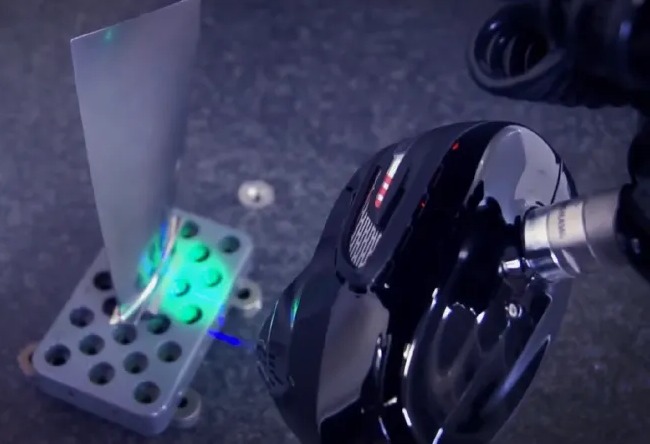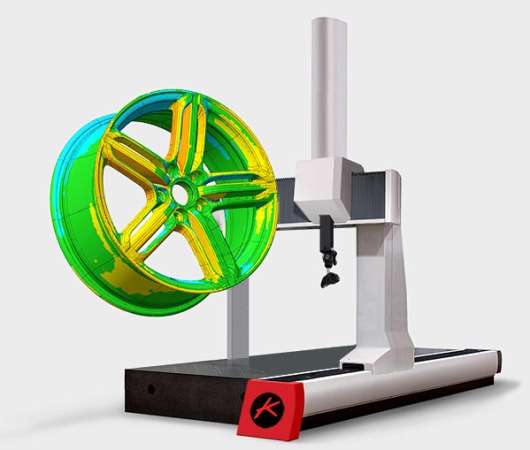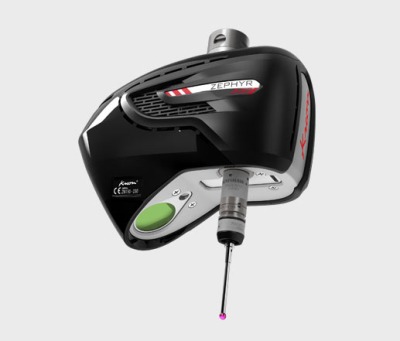 Laser line scanners are well respected and intensely utilized on manual portable arm coordinate measuring devices, for both reverse engineering and part inspection, in numerous industries, including automotive, aerospace, tooling, and prototyping. The use of laser line scanners on traditional fully automatic CMM’s has been presented at trade-shows for more than a decade. Only in more recent years have they started to perform the front line role envisaged in production part inspection.
Laser line scanners are well respected and intensely utilized on manual portable arm coordinate measuring devices, for both reverse engineering and part inspection, in numerous industries, including automotive, aerospace, tooling, and prototyping. The use of laser line scanners on traditional fully automatic CMM’s has been presented at trade-shows for more than a decade. Only in more recent years have they started to perform the front line role envisaged in production part inspection.
Why is that?
Price for sure was a significant factor in the early days where the scanner could cost as much as the CMM. The ability of CMM software to manage point clouds, with automatic geometry extraction and nominal CAD analysis, of both features and surfaces, without any user interaction, being another. Today, the cost of laser scanners has fallen, and software’s have evolved, whereby laser scanning as part of a part inspection, in a common coordinate system, and in combination with tactile probing is now a logical progression for the CMM. Improved CMM cycle times, in-depth analysis of complex surface geometries today are perfectly feasible and practical extending CMM performance and its longevity as the primary inspection tool in manufacturing industries. The days of a separate software for laser scanning and point cloud analysis are long gone; today software’s provides a seamless sensor change-over and dual CMM inspection functions automatically within a common inspection part-program. The multi-sensor laser scanning CMM is now an economic and practical reality.
 The original red-line laser scanners had associated technical issues scanning shiny parts (which most machined parts are) mandating powder coating of the part in many circumstances. Obtaining reliable and consistent data collection and repeatable results were somewhat ‘hit and miss’ when attempting to measure production parts repetitively. The current generation of blue-light laser line scanners more readily handle shiny parts and with much less speckle requiring significantly less data filtering.
The original red-line laser scanners had associated technical issues scanning shiny parts (which most machined parts are) mandating powder coating of the part in many circumstances. Obtaining reliable and consistent data collection and repeatable results were somewhat ‘hit and miss’ when attempting to measure production parts repetitively. The current generation of blue-light laser line scanners more readily handle shiny parts and with much less speckle requiring significantly less data filtering.
High Productivity and Accuracy
Most CMM manufacturers now offer laser-line scanning sensors as an option on new machines. Independent laser scanning sensor supplier, KREON, provides sensors to some OEM’s along with addressing the huge potential CMM retrofit market with packaged solutions including software from independent metrology software providers Metrologic (MetrologX4) and Innovmetric (Polyworks).
The CMM laser scanner retrofit market is deemed to be considerable given the installed base of machines. The ‘thirst of industry’ to have much more knowledge of their manufactured parts than that obtained by measuring just a few key control features is driving the market along with the ongoing transition to automate away from manual labor intensive tasks and functions.
Multi-sensor CMM systems allow user to select tactile probing or scanning sensor to measure component features with the decision often based on the principle that tight tolerance features should be measured by tactile probes, while other more loosely tolerance elements can be laser scanned.
 Uniquely, Kreon offer its patented Zephyr III blue laser-line scanner with an integrated touch probe negating the need to perform an automatic sensor change when measuring external and shallow part features, further enhancing CMM productivity.
Uniquely, Kreon offer its patented Zephyr III blue laser-line scanner with an integrated touch probe negating the need to perform an automatic sensor change when measuring external and shallow part features, further enhancing CMM productivity.
Laser scanners are now more compact and lighter, allowing their mounting on motorized indexing heads, and providing full CMM dexterity for the measurement of all accessible part features and surfaces.
The Kreon Zephyr III scanner offers acquisition speeds of 600,000 points/second, allowing CMM users to quickly obtain dense part point clouds. 2,000 points per laser line provide a 15µm resolution scan and with a 5 μm accuracy according to the ISO 10360-8 accuracy certification standard.
The CMM is finally playing catch-up with the capabilities offered by the manual portable systems with the advantage of automatic measurement on repetitive production parts.
For more information: www.kreon3d.com
Tags: 3d vina, hiệu chuẩn, hiệu chuẩn thiết bị, Laser Scanners Transition to Automatic CMM Measurements, máy đo 2d, máy đo 3d, máy đo cmm, sửa máy đo 2d, sửa máy đo 3d, sửa máy đo cmm
